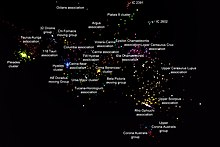Association stellaire
Une association stellaire, terme introduit en 1949 par l'astrophysicien arménien Viktor Amazaspovitch Ambartsumian, est un groupe d'étoiles dont le même mouvement propre trahit une origine commune. Contrairement à un amas stellaire au sein duquel les étoiles sont en interaction gravitationnelle, les étoiles d'une association ne sont plus soumises à cette force.

Parmi les associations les plus étudiées en astrophysique, on citera les associations OB, groupements de supergéantes bleues, très chaudes, jeunes et massives.
Groupe mouvant
modifierListe d'associations stellaires et groupes mouvants
modifierSource[1] :
Notes et références
modifier- ↑ (en) Jonathan Gagné, « Young Moving Groups » (consulté le ).
- (en) B. Zuckerman, Laura Vican, Inseok Song et Adam Schneider, « Young Stars Near Earth: The Octans-Near Association and Castor Moving Group », The Astrophysical Journal, vol. 778, no 1, (DOI 10.1088/0004-637X/778/1/5, lire en ligne, consulté le ).
- ↑ (en) D. Annie Dickson-Vandervelde, Emily C Wilson et Joel H. Kastner, « Gaia-based Isochronal, Kinematic, and Spatial Analysis of the ɛ Cha Association », The Astronomical Journal, vol. 161, no 2, , p. 17, article no 87 (DOI 10.3847/1538-3881/abd0fd, Bibcode 2021AJ....161...87D, arXiv 2011.06621)
- ↑ https://arxiv.org/pdf/1708.09541.pdf
Bibliographie
modifier- (en) Eric E. Mamajek, « A Pre-Gaia Census of Nearby Stellar Groups », Proceedings of the International Astronomical Union, IAU Symposium, vol. 314, , p. 21-26 (DOI 10.1017/S1743921315006250, Bibcode 2016IAUS..314...21M, arXiv 1507.06697)